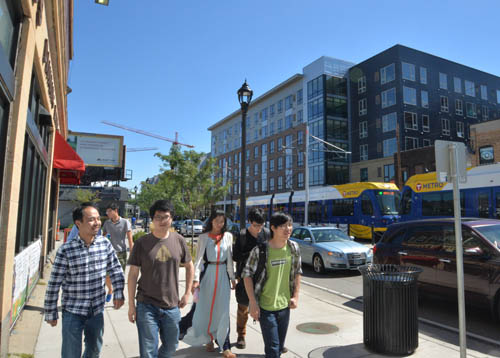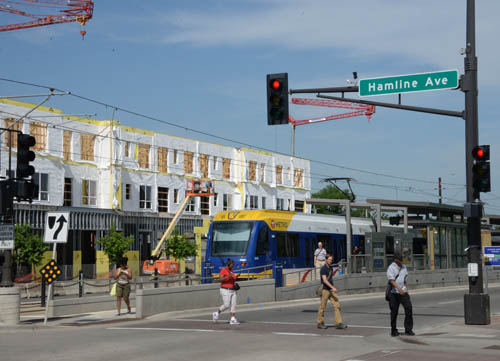From artist lofts to family affordable housing to luxury apartments, new housing development has been a significant contributor to the estimated $3 billion in development activity along the METRO Green Line since 2009.
At least 13,700 housing units have been created or are in the pipeline within one-half mile of the light rail corridor, according to figures compiled by the METRO Green
Line Project Office.
“The Green Line is clearly an attractive corridor for new investment in housing, especially in already strong market areas such as the two downtowns and the University of Minnesota,” said Gretchen Nicholls, Program Officer for LISC Twin Cities, a nonprofit dedicated to neighborhood revitalization.
Dave Menke is President of Opus Development Company, L.L.C., a national real estate development firm with headquarters in Minneapolis. Opus has created several mixed-use, market-rate multifamily developments in downtown Minneapolis and around the University of Minnesota. The Nic on Fifth in downtown and Stadium Village Flats and The Station on Washington at the U are at the doorstep of light rail.
“We look for key transportation nodes and locations with access to multiple transportation options that also support a mix of uses, including retail,” Menke said. “The theme of our developments has been urban vitality, the whole idea of live, work, and play.”
Creating and preserving a mix of housing affordability around emerging transit investments

The Council’s Housing Policy Plan recognizes that as the region makes significant investments in transit, such as the Green Line, we must also take steps to minimize and mitigate the impacts of neighborhood change along transit that can displace existing low-income residents. Creating and preserving a mix of housing affordability along transit leads to more vibrant places that attract additional investment.
While market-rate housing represents the bulk of housing created on the Green Line corridor, dozens of organizations—local governments, nonprofits, foundations, and the Council—have been working to ensure that affordable housing is part of the picture. In 2012 these partners, through an effort called The Big Picture Project, created an affordable housing coordinated plan for the corridor.
“It’s been a heavy lift to ensure that affordable housing has been created and preserved across the corridor, but we are definitely seeing progress,” Nicholls said. “One out of seven new housing units built between 2011 and 2014 on the corridor is affordable to households with incomes at 60% of area median income or below.”
Between 2011 and 2014, 2,375 subsidized long-term affordable housing units on the corridor were completed—within easy reach of the Big Picture Project’s baseline goal of 2,540 affordable units by 2020. Importantly, nearly 3 out of 4 were existing affordable units for which long-term affordability was preserved. Preservation efforts protect existing residents from being displaced by the rising rents that can occur when the market heats up in neighborhoods around transit stations.
New affordable housing can add to diversity of housing stock

“What isn’t often recognized is that creating new affordable housing in lower-income neighborhoods often adds diversity to the housing mix,” said Libby Starling, Manager of Regional Policy and Research at the Council. “Average rents in areas of concentrated poverty can be as much as one-third less than rents in some subsidized affordable housing. New ‘affordable’ housing contributes to the overall mix of housing affordability we want to see.”
“From a goal perspective we are doing terrific,” said Jonathan Sage-Martinson, former Director of the Central Corridor Funders Collaborative and now Director of Saint Paul’s Planning and Economic Development Department. “We are committed to working aggressively to help achieve the stretch goal of 4,500 affordable new and preserved affordable housing units by 2020.”
But just as important to the city, Sage-Martinson said, is that the affordable housing is well-dispersed along the line. “We’re proud of the fact that nearly every stop has some investment in affordable housing.”
Housing choices for people in all stages of life and economic means
The city also has a preference for high-density, mixed-income development that is oriented to the Green Line. He cited 2700 University, Hamline Station, and the Western University Plaza developments as important examples. Adding significant amenities to neighborhoods along the line, like the Mekong Night Market at Western, and Dickerman Park near Fairview, are incentives for the location of market-rate housing, he said.
METROPOLITAN COUNCIL
LIVABLE COMMUNITIES GRANTS
TO GREEN LINE HOUSING
- 32 LCA grants totaling $16.4 million
- 22 market-rate and affordable housing developments
- Leveraging $708.7 million estimated development costs
“Our vision for the Saint Paul portion of the line is really mixed-income neighborhoods, so people of all incomes and all stages of life can access and enjoy the benefits that light rail provides,” said Sage-Martinson.
Saint Paul’s vision is in alignment with the Council’s overall housing policy priority is to create housing options that give people in all stages and of all economic means viable choices for safe, stable, and affordable homes in the communities where they want to live.
Transportation corridors are ‘compelling’ for siting housing
Marvin Plakut, President and CEO of Episcopal Homes, said the Green Line has been an influencing factor on his company’s plans to expand at their Fairview location and develop housing at other stations along the line, including Lexington Avenue Station and Dale Street Station.
“Expanding at those transportation hubs where there is a light rail station—that is a very compelling feature,” Plakut said.
Opus’ Dave Menke agrees. “In Chicago we are very purposefully locating projects along transportation corridors,” he said. “That will become more prevalent here in the Twin Cities as our rail system matures.”
People, places and connections: Green Line residents are enthusiastic about light rail.